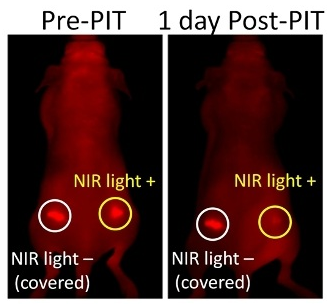Light targets and destroys cancer cells
November 10, 2011

Image of a mouse with two implanted tumors (circles) that received the photoimmunotherapy (PIT) agent. One tumor was covered (white circle) but the other tumor (yellow circle) received a short course of harmless near infrared light. One day after exposure to the light, the treated tumor is dramatically smaller than the covered tumor demonstrating the effectiveness of PIT. (Credit: NIH)
National Cancer Institute researchers have designed a light-based therapy that allows for selective destruction of tumor cells in mice without harming surrounding normal tissue.
It could theoretically work against tumors in humans, such as those of the breast, lung, prostate, as well as cancer cells in the blood such as leukemias, say the scientists. Current photodynamic therapy is not specific for cancer cells, resulting in damage to surrounding normal tissue.
This new type of treatment, called photoimmunotherapy, or PIT, uses light to rapidly and selectively kill cancer cells. To create their PIT, the scientists coupled a monoclonal antibody or MAb, which recognizes specific proteins on the surface of cancer cells, with a photosensitizer — a molecule that, when exposed to light of the appropriate wavelength (near-infrared), rapidly damages cells.
Photoimmunotherapy using MAb-IR700 does not appear to harm normal cells, unlike conventional photosensitizers which can cause damage to healthy tissue. The light that is required to activate conventional photosensitizers can penetrate through only about 0.8 centimeters of tissue (about a third of an inch), while the near-infrared light used to activate IR700 can penetrate tissue to a depth of several centimeters.
The study also found antibody doses required for diagnosis were significantly lower than those required for therapy. Nevertheless, after MAb-IR700 exposure, the targeted tumors decreased in size and eventually disappeared, suggesting a potential means of controlling cancers with far lower doses of MAb than are usually administered to cancer patients, say the scientists.
Ref.: Makoto Mitsunaga, et al., Cancer cell–selective in vivo near infrared photoimmunotherapy targeting specific membrane molecules, Nature Medicine, 2011; [DOI:10.1038/nm.2554]
